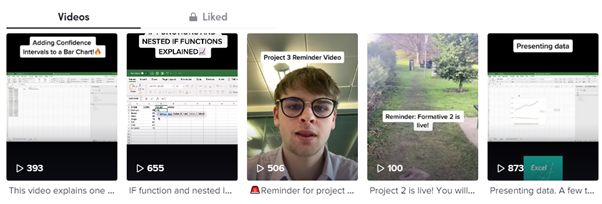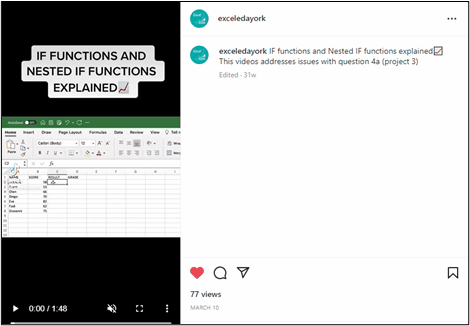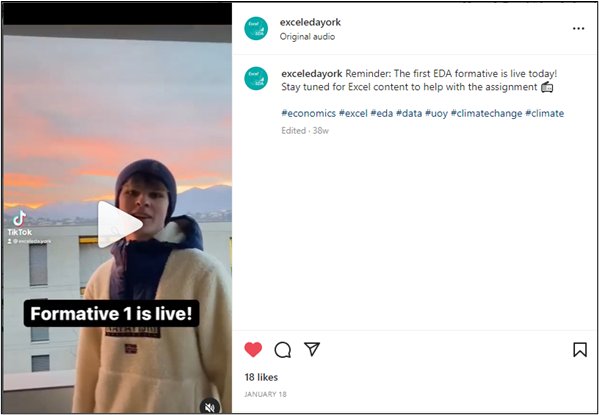Teaching data analysis and econometrics asynchronously with social media and peer support
Mathilde Peron, Lilian Joy, Michael Thornton, and Annabel Tompson
University of York
Published February 2023
Introduction
Economic Data Analysis (EDA) and Econometrics are two core first- and second-year modules, with around 200 Economics students each at the University of York. Both modules are assessed with an individual project for which students need to be proficient in Excel and Stata. Before 2020, conceptual lectures were complemented with practical computer sessions held in person in dedicated labs. These sessions can offer valuable, interactive resources for demonstration and experimentation. However, computer labs tend to be expensive, tightly rationed and crucially have been largely unavailable for about two years.
Since the pandemic, computer sessions have been replaced by asynchronous activities supported by step by step videos recorded by lecturers as well as access to external resources such as Core Doing Economics. Practical sessions for EDA were also re-designed according to well-researched pedagogical principles, such as motivation via real-world problems and work in small groups with assigned roles (Yilmaz & Karaoglan, 2019) facilitated by an initial socialisation activity. Lecturers also use various institutional tools to promote social interaction (VLE discussion boards, Padlets and online quizzes).
Students’ feedback on pre-recorded videos was overall positive, mainly because they can work at their own pace and re-access the material when working on their summative project. Nevertheless, engagement was limited, with especially little uptake of the socialisation and peer support activities. We also observed a gap between what students said they wanted (taken from module feedback and the Jisc (2021) report) and what they actually did as illustrated in the table below:
Table 1: Student needs versus behaviour
| What students said they wanted | What they actually did |
|---|---|
| “opportunities to talk and ask questions of lecturers and peers” | Didn’t speak to their group after ice breakers. Modest use of office hours. Shyness in Q&A sessions. |
| “step by step resources.” | Didn’t refer to the resources. Wanted live step by step support. |
| “learning to be more interactive”. | Few completed the online VLE quizzes or interacted on the padlets. |
| “more opportunities for small group support.” | Worked individually, not together, on tasks. |
Brown et al (2020) argues that having to learn university-specific tool sets can be a technological barrier for engagement, making online interactions ‘unproductive and stilted’ (Jisc, 2021). The Beyond the Lab (BtL) project was thus created, aimed at peer support for students with social tools familiar to them, such as Instagram and TikTok. The project was funded by the Royal Economic Society over the academic year 2021/22 and consisted of three main activities:
- Recruiting four student mentors to act as content producers and community managers;
- Producing social media content on Excel and Stata, reminders about upcoming deadlines and community-oriented posts;
- Creating opportunities for peer-support with two in-person workshops and direct messaging.
We hoped the combination of social media and peer-support might be a good replacement for the communication dynamics of the traditional lab sessions and enhance blended learning, improve student engagement and help students feel supported and part of a learning community.
Channelling near peer support
79% of surveyed students used Instagram so this was the chosen platform for both modules, with the EDA module also running a TikTok account. Email addresses were set up specifically for the social media channels. These were then used to create the ‘handles’ for each channel, namely @exceledayork on Instagram and exceledayork on TikTok and @Econometrics2york on Instagram.
Working in pairs, the mentors created content they thought would engage the students. These included simple videos to introduce themselves and to create a welcoming presence, tips and ‘hacks’ on using Excel and Stata, and messages that served as nudges. Overall, 43 posts were created with 162 followers over 10 weeks. Interestingly, even posts where mentors recorded themselves speaking to the camera were viewed a significant number of times.
On TikTok, adding confidence intervals to a Bar Chart received 393 views. Nested IF functions explained received 655 views. The mentor just facing the camera to remind people about the project received 506 views.

More examples of the posts made can be seen in the appendix below.
The student mentors also ran two in-person sessions to supplement their online presence, attended by about 10 students in each session.
How successful was the project?
Students mentioned that it “helped (them) to remember deadlines” and that they found it was “useful highlighting key parts of the lectures”
We evaluated the project with surveys and interviews. Fourteen surveys were returned (out of 400!) and interviews were conducted with the four mentors, two further students and two module convenors. Returns on surveys are typically very low with Economics students and getting feedback can be hard work. This makes the 162 followers of the channels a pleasingly high number. The channels drew over 2495 views for the videos over the 10 weeks (although not all the views can be attributed solely to Economics students). The number of views for posts are unknown as posts can be viewed without any interaction.
When asked why they had engaged with the social media channels, and whether they found it helpful, students mentioned that it “helped (them) to remember deadlines” and that they found it was “useful highlighting key parts of the lectures”. Others said “overviews were good after learning lots of content all week” and that it was “helpful to have bite size chunks of the most important information”. Some students also mentioned it was convenient to see the reminders on social media as they already use it a lot and “it gave a different perspective”. One student’s feedback in the survey indicated they had not attended many lectures but appreciated the range of online content and engagement points made available to them so they felt included.
However, other students commented they felt learning content added to a social media channel was unnecessary:
“Going to Insta for just Econometrics would lead to an hour or more of scrolling on unnecessary posts thus wasting more time.”
Other sources of feedback on the impact of using social media with near-peer support came from module feedback and a teaching prize won by the module convenor:
“She really made the module feel like a community (something which was needed from the isolation of 2020 when we started).”
“She used music and social media to keep the lectures interesting and entertaining. Throughout the lectures, she made sure everyone was understanding and didn’t leave anyone behind.”
Tutors observed that students were asking more advanced questions compared to previous years. They also felt there was an improvement in student engagement behaviours overall:
“Students seem more engaged this year; they are coming to lectures, asking more questions and more are turning up to office hours.”
Finding student mentors took a lot of promotion but in the end, the student mentors experienced lasting benefits from being involved in the project - one student built on their skills to co-present on the findings of the project at a national webinar. Another student was observed to be more engaged and focused in their own studies in the third year.
Conclusion
In terms of meeting students’ needs (see Table 1), the social media channel and face to face peer support session provided students with additional ways to interact with their peers and receive group support. The social media videos broke down concepts into smaller step by step resources and provided a way for students to interact through the platforms.
The overall provision in the department was arguably more inclusive and catered to a more diverse range of students simply by providing some different learning approaches. It helped to increase and diversify participation opportunities for students and it also showed students the tutors cared about how they learned. Students valued having a ‘time efficient’ way of revising key concepts, timely reminders of deadlines and being able to reach out to peers for support. By taking into account their preferences for viewing shorter videos, using their own familiar social tools and having students as active partners (Jisc, 2021), we moved closer to meeting student expectations.
Overall, it could be said that the project was a success and helped to support blended learning approaches and create community. With significant engagement numbers, the use of social media and peer mentors will be embedded into the modules going forward, with some recommendations below:
Lessons learned
- Work with an employability adviser to raise student awareness of how participating in opportunities like working as a peer mentor can significantly improve their CVs.
- Use videos rather than graphics Posts as they generate better analytics on engagement. Instagram is preferred to TikTok.
- Promote ‘student hacks’ that are not necessarily in the curriculum but can endorse the usefulness of learning Excel or Stata.
- Use a mix of relatable in-person videos and ‘how-to’ videos.
- Complement the social media channels with in-person peer-led sessions.
- Impact is not easy to measure but is worth the effort.
References
Brown, A., Lawrence, J., Basson, M., & Redmond, P. (2020). A conceptual framework to enhance student online learning and engagement in higher education. Higher Education Research & Development, 1–16. https://doi.org/10.1080/07294360.2020.1860912
Jisc. (2021). Student digital experience insights survey 2020/21. https://www.jisc.ac.uk/reports/student-digital-experience-insights-survey-2021-22-higher-education-findings
Yilmaz, R., & Karaoglan Yilmaz, F. G. (2019). Assigned Roles as a Structuring Tool in Online Discussion Groups: Comparison of Transactional Distance and Knowledge Sharing Behaviors. Journal of Educational Computing Research, 57(5), 1303–1325. https://doi.org/10.1177/0735633118786855
Appendix: Example Posts
Short-form videos provided a more personable mode of learning on Instagram:

Nudges and reminders served to create more engagement with the module:


Other content aimed at building a sense of community, with a friendly tone and invitations to ask questions.


